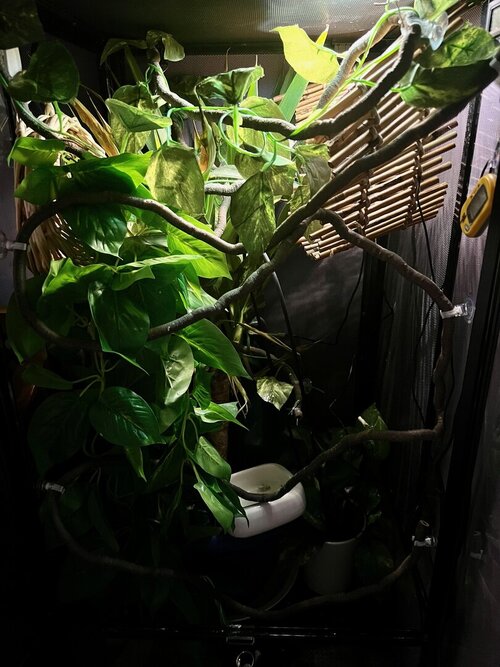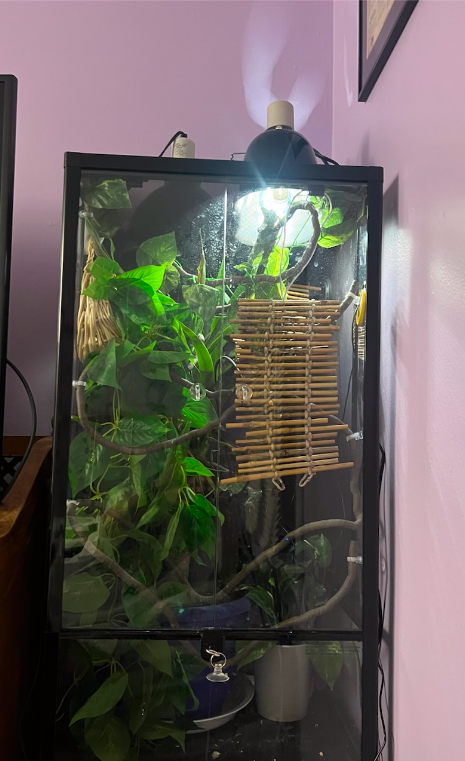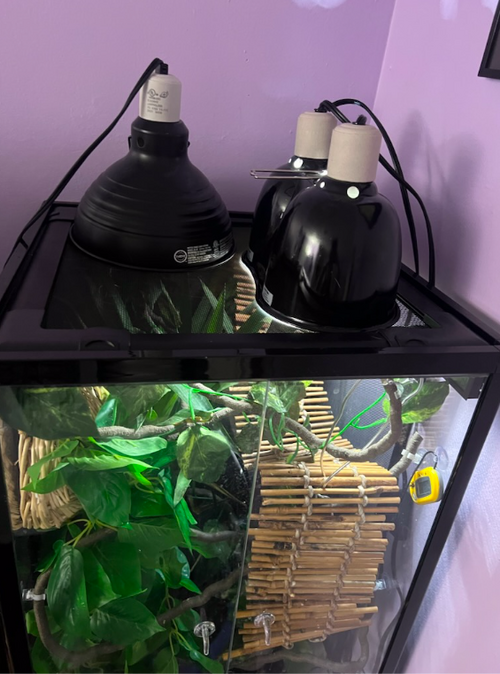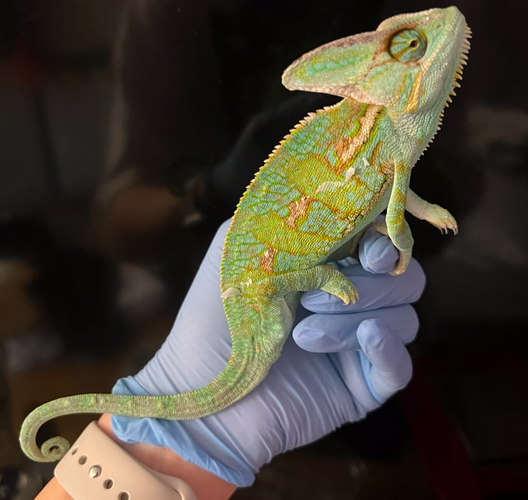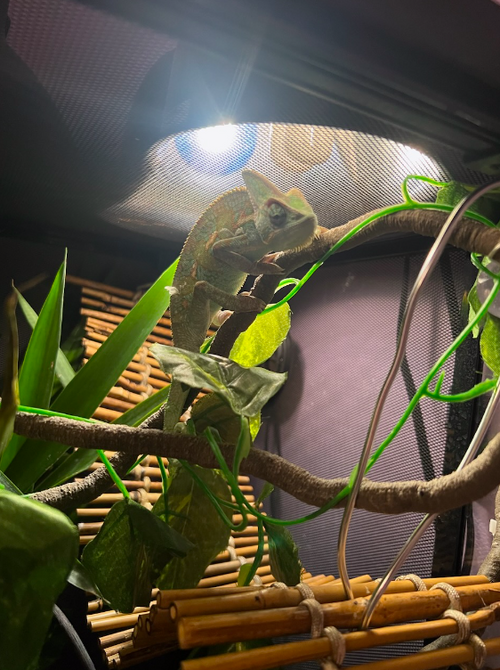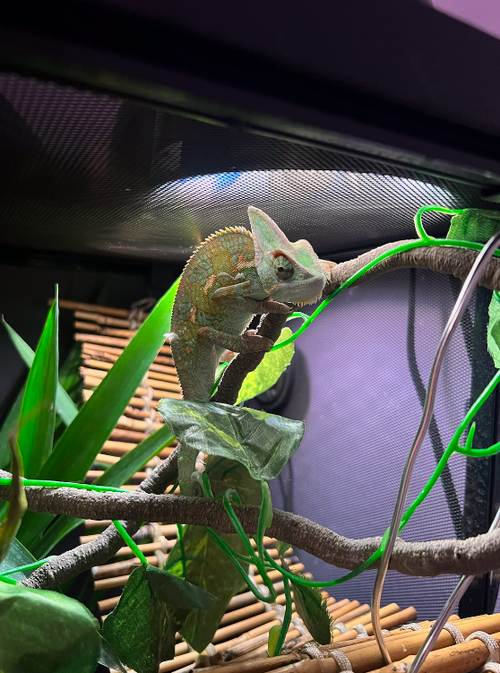KikiHill
New Member
Hi everyone,
I have an 8 month old (I believe female) veiled chameleon named Kiki. She is my first chameleon and of course care about her a lot and want the best for her. I got her in October and she was thriving the first few months I had her and she grew pretty quickly. However, lately she seems to be having some health issues. Starting around the end of January she stopped eating- she began shedding shortly after that, so I thought OK this could be normal. I continued to leave crickets in her bowl every day with no results. Then tried bringing the crickets closer to her basking area because I thought maybe she was having trouble seeing them. One day she tried to grab one, but couldn't because it seemed like she was having trouble extending her tongue. I ended up using my tongs to grab the cricket and put it in her mouth. Since then, she'll look at the crickets but hasn't tried to grab one. I've started force-feeding her because it seemed like she was getting weaker. I'll usually spray a drop of water on the tip of her nose and when she goes to open her mouth I'll put a cricket in there- I'm just trying to keep her alive at this point because I know things can turn very quickly when reptiles stop eating.
These are some details about Kiki and her enclosure:
Habitat- (photo attached below) Mesh enclosure with glass doors at the front, contains fake plants/vines and two live plants (Dracaena and golden pothos). Her enclosure is in my room but I'm rarely there during the day so she gets a lot of alone time.
Heat/Light- Basking bulb and a zoomed reptisun 5.0 UVB that sit on top of the mesh lid. Also added a ceramic heat emitter on top because her basking area was getting too cold in the winter. Her basking area remains around 90 degrees F (measured with a digital thermometer). Her enclosure has plenty of space to move away from the heat if need be. Nighttime temp is usually 68-72.
Humidity- I mist her cage for a few minutes every morning and every night- I had an automatic mister but it stopped working so I've been spraying until I can find an alternative. Because of the winter, I have had some trouble keeping the humidity in her enclosure above 40%-- when I got home today it was at 37% (measured with a digital hygrometer). Could this be why she has been sick lately? Regardless, any recommendations to raise the humidity will be greatly appreciated!
Diet- She normally has about 3-7 medium to large crickets per day dusted with calcium (without D3) or reptivite (once per week). Sometimes I'll throw in a green, like kale. The crickets are not free to roam and they are in an escape proof bowl toward the bottom of her enclosure. I've also tried giving her black soldier fly larvae and dubia roaches but she doesn't seem interested in them.
Temperament- She's pretty feisty and usually hisses at me in the morning, so I try not to bother her. I have been handling her as little as possible and have only handled her when I am trying to force-feed her. She is usually dark green/brownish when she is basking, a lighter green if she's just hanging out, and then very light green when she's sleeping.
I would really appreciate it if anyone has any recommendations about her habitat or any ideas of what I can do to help her. Of course I have no objection taking her to an exotic vet but the options in my area are fairly limited. Thank you in advance!!
I have an 8 month old (I believe female) veiled chameleon named Kiki. She is my first chameleon and of course care about her a lot and want the best for her. I got her in October and she was thriving the first few months I had her and she grew pretty quickly. However, lately she seems to be having some health issues. Starting around the end of January she stopped eating- she began shedding shortly after that, so I thought OK this could be normal. I continued to leave crickets in her bowl every day with no results. Then tried bringing the crickets closer to her basking area because I thought maybe she was having trouble seeing them. One day she tried to grab one, but couldn't because it seemed like she was having trouble extending her tongue. I ended up using my tongs to grab the cricket and put it in her mouth. Since then, she'll look at the crickets but hasn't tried to grab one. I've started force-feeding her because it seemed like she was getting weaker. I'll usually spray a drop of water on the tip of her nose and when she goes to open her mouth I'll put a cricket in there- I'm just trying to keep her alive at this point because I know things can turn very quickly when reptiles stop eating.
These are some details about Kiki and her enclosure:
Habitat- (photo attached below) Mesh enclosure with glass doors at the front, contains fake plants/vines and two live plants (Dracaena and golden pothos). Her enclosure is in my room but I'm rarely there during the day so she gets a lot of alone time.
Heat/Light- Basking bulb and a zoomed reptisun 5.0 UVB that sit on top of the mesh lid. Also added a ceramic heat emitter on top because her basking area was getting too cold in the winter. Her basking area remains around 90 degrees F (measured with a digital thermometer). Her enclosure has plenty of space to move away from the heat if need be. Nighttime temp is usually 68-72.
Humidity- I mist her cage for a few minutes every morning and every night- I had an automatic mister but it stopped working so I've been spraying until I can find an alternative. Because of the winter, I have had some trouble keeping the humidity in her enclosure above 40%-- when I got home today it was at 37% (measured with a digital hygrometer). Could this be why she has been sick lately? Regardless, any recommendations to raise the humidity will be greatly appreciated!
Diet- She normally has about 3-7 medium to large crickets per day dusted with calcium (without D3) or reptivite (once per week). Sometimes I'll throw in a green, like kale. The crickets are not free to roam and they are in an escape proof bowl toward the bottom of her enclosure. I've also tried giving her black soldier fly larvae and dubia roaches but she doesn't seem interested in them.
Temperament- She's pretty feisty and usually hisses at me in the morning, so I try not to bother her. I have been handling her as little as possible and have only handled her when I am trying to force-feed her. She is usually dark green/brownish when she is basking, a lighter green if she's just hanging out, and then very light green when she's sleeping.
I would really appreciate it if anyone has any recommendations about her habitat or any ideas of what I can do to help her. Of course I have no objection taking her to an exotic vet but the options in my area are fairly limited. Thank you in advance!!

